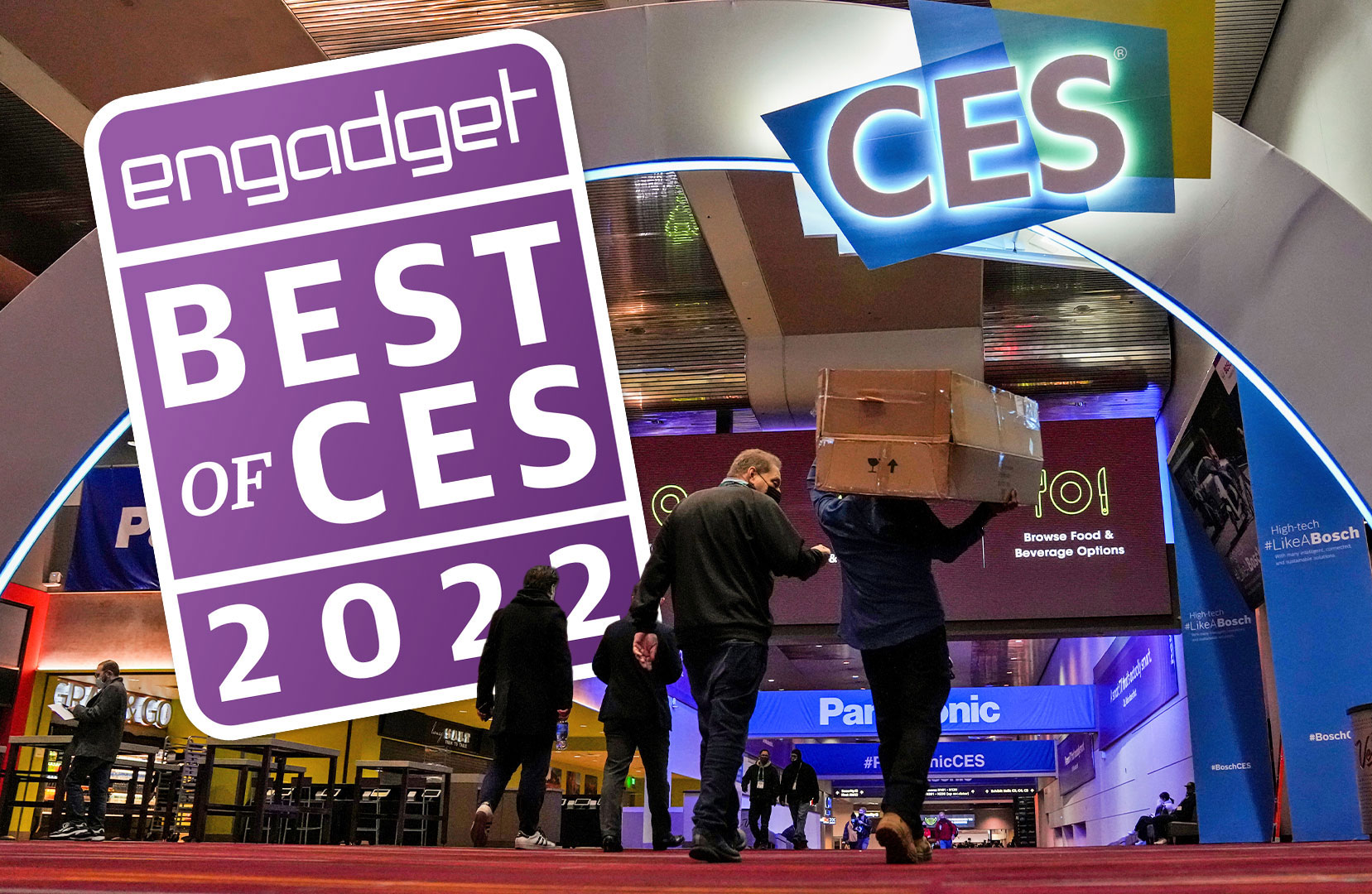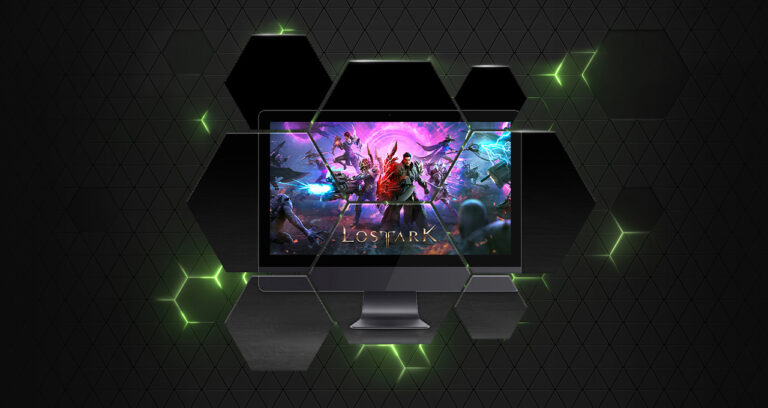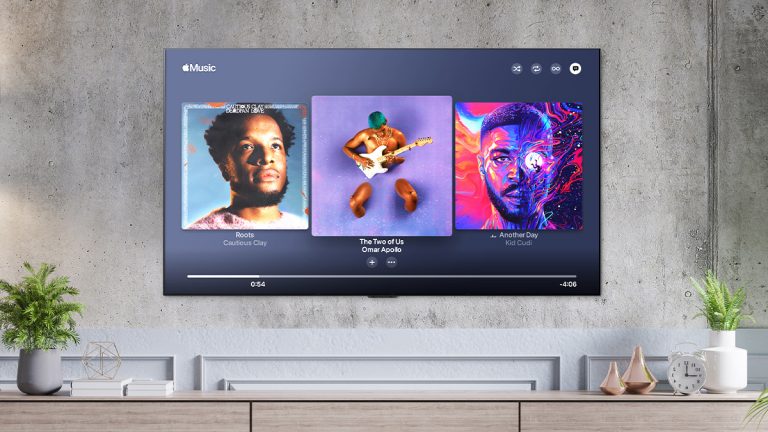Engadget’s Best of CES 2022
You all know what they say about the best-laid plans. Though Engadget intended to send a few editors to cover CES in person, we later decided amid surging covid cases that it would be best if our entire staff just stayed home and covered the show remotely. In the end, too, we also decided it would be easiest, under these very fluid circumstances, to do our own thing for our annual CES Awards, which since 2014 we have produced in partnership with the Consumer Technology Association, the trade group that organizes CES itself. Though we can’t hand out awards in person this year, we do still have opinions. And we’re about to share them with you.
What follows are all of our favorites from CES 2022 which, despite some stormy press, turned out to be a surprisingly busy show (if not in foot traffic, then certainly in hard news). As in years past, we arrived at these picks by first asking the editors who cover these categories year-round to weigh in on a shortlist. Then our wider team voted using a ranked-choice system. Maybe one day we’ll also tell you about the dark-horse favorites that almost, but didn’t quite, make the cut. — Dana Wollman, Editor-in-Chief
Best Accessibility Product
OrCam MyEye Pro
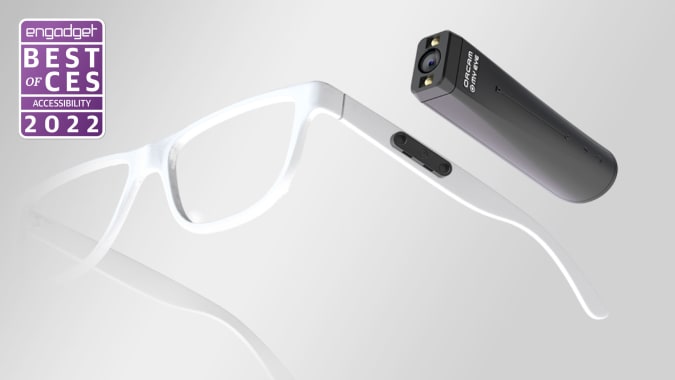
OrCam
For people with low vision or difficulty reading, camera-based gadgets with object recognition can make life a little easier. OrCam’s MyEye Pro is a wearable camera module that can be attached to any pair of glasses. Like previous generations, the MyEye Pro can read text, identify objects and faces and tell the wearer what it sees via an onboard speaker or paired Bluetooth headphones. In addition to a touch-sensitive control panel, OrCam offers voice control via the company’s own assistant with the “Hey OrCam” hotword. The Pro also features a faster processor than older models, an additional microphone, stronger magnets and improved tactile cues. It has a new interactive “Smart Reading” feature that lets users ask their MyEye to quickly find specific information like phone numbers, the total on a bill, a particular word on a page and more.
MyEye Pro is one of a few assistive devices built specifically to help people with vision impairments or reading disabilities. Though smartphones can arguably perform similar tasks, the fact that the OrCam can be mounted on spectacles makes it easier for extended reading or all-day use. The company needs to address some usability issues, and like most assistive devices the MyEye is very expensive starting at $3,990. But with greater awareness of the existence of such products, perhaps more insurance providers will consider covering some of the cost. — Cherlynn Low, Deputy Editor / Reviews
Best Health and Fitness Product
Withings Body Scan
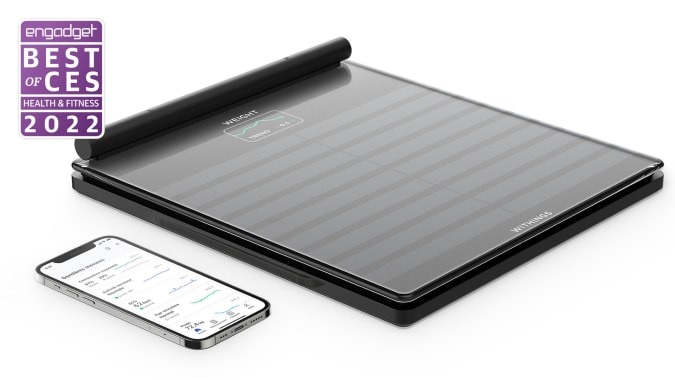
Withings
Withings has been doing all it can to push the boundaries of what a bathroom weighing scale can do for a long while now. This year at CES, the company unveiled the Withings Body Scan, which aims to bring a number of new health-monitoring technologies into your home. The Body Scan’s most obvious new feature is the pull-out handlebar that you’ll hold in front of your waist while you’re standing on the deck. This allows the device to run an ECG to check on your heart health, offer up sequential body composition data and, most intriguing, analyze your nerve activity.
It’s not just the breadth of data the Body Scan promises to analyze, but the claimed depth that impressed us. Withings says that its six-lead ECG will produce medical-grade results and that its output can easily be read by a cardiologist. Meanwhile, the nerve activity tracking will look for signs of nerve degeneration, which can be caused by obesity (and treated with appropriate remedial action). It’s a hell of a lot of tech to pack into one consumer device, and if Withings makes good on its promises, it may become the bathroom scale of choice for anyone who wants to keep tabs on their health. — Daniel Cooper, Senior Editor
Best Wearable
Razer Zephyr Pro
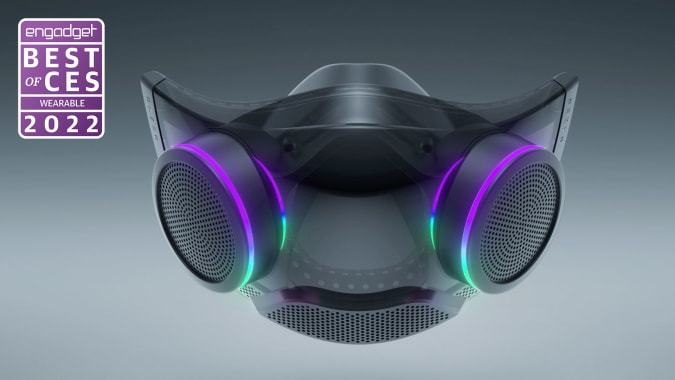
Razer
In a year where many CES attendees decided to stay home amid rising COVID cases, it feels fitting that our favorite wearable at the show was a smart mask. Tech companies had already started to put their spin on face coverings, with Razer’s original $100 Zephyr mask and LG’s PuriCare Mask. With a gamer steampunk-inspired design, the first–gen Zephyr combined N95 filters, dual-fan active air filtration system and (of course) RGB lighting all in one striking device.
Razer followed up this year with the Zephyr Pro and one new feature in particular is worth highlighting: the ability to amplify your voice by 60 decibels up to one meter away. It solves a problem most of us have experienced at some point over the past couple of years: You try to order a coffee and the barista behind the counter can’t hear you over your mask, not to mention the protective plastic wall separating you both. In theory, if you’re wearing the Zephyr Pro, you shouldn’t have this problem. Whenever you don’t want to use the feature (or maybe just want to conserve battery), you can turn off voice amplification.
We don’t know exactly when the Zephyr Pro will come out, but Razer has said it will cost $150, or $200 for the starter pack with 100 days worth of filters. Is the Zephyr Pro a bit excessive? Yes. Will the RGB lighting make you look ridiculous? You bet. But even so, we have to hand it to Razer for making masked interactions just a little easier. — Valentina Palladino, Commerce Editor
Best Transportation Tech
Chevrolet Silverado EV
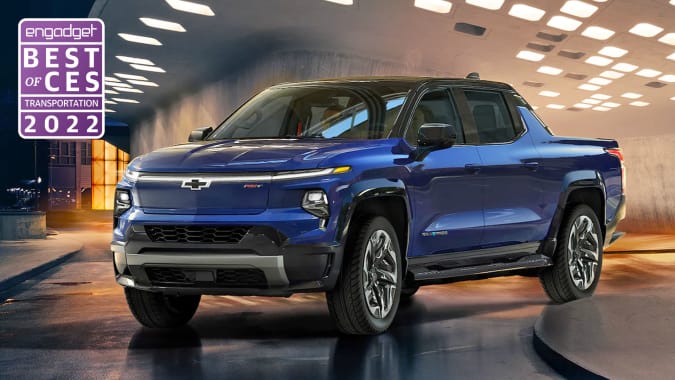
Chevrolet
2022 is already shaping up to be the year of the electric pickup, so it was no surprise that GM CEO Mary Barra took to the CES stage on Wednesday to officially unveil the American automaker’s second electrified truck, the Chevrolet Silverado EV. We shouldn’t need to explain why Chevy’s best-selling vehicle going electric is a big deal.
The new Silverado joins the Hummer EV in GM’s burgeoning electric truck lineup (soon to be accompanied by Blazer and Equinox EVs) and will arrive in two versions: the RST First Edition, a limited-run production with an MSRP just north of $100,000, followed by the far more affordable WT fleet edition and standard RST – both of which start at around $39,900.
Positioned to compete directly with Ford’s forthcoming F-150 Lightning, the Silverado EV RST will offer a GM-estimated 400 mile range, up to 664 horsepower and 811 ft-lb of torque with the ability to tow up to 10,000 pounds. The WT version will be slightly less powerful but still boasts 510 hp, 615 lb-ft of torque and 8,000 pounds of towing capacity. Both the RST and WT versions will enter production alongside the Hummer EV line at GM’s new Factory ZERO electric vehicle production facility in 2023. — Andrew Tarantola, Senior Editor
Best Home Theater Product
Samsung Eco Remote (2022)
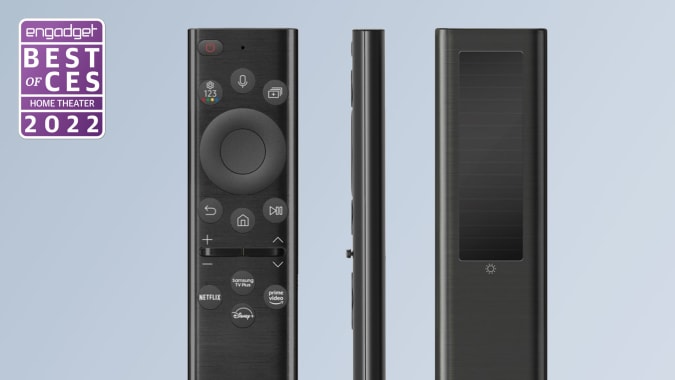
Samsung
At CES last year, Samsung debuted an Eco Remote that uses indoor or outdoor light to recharge via a solar panel. This year, the company took things a step further. The 2022 model brings back the solar panel and adds the ability to recharge using radio frequency (RF) signals from your WiFi router. Since you don’t need to replace the battery, this eliminates the need to hunt for AAAs (which would eventually be destined for a landfill).
Using energy that otherwise goes to waste, the new Eco Remote’s low power requirements make it a good choice for harvesting RF waves. The device, available with either a black or white finish, is also equipped with dedicated buttons for streaming services to give you one-touch access. Sure, you’ll need a Samsung TV to use it, but the greener power sources certainly help the device live up to its name. And hopefully, Samsung’s clever use of RF waves can serve as inspiration for other TV manufacturers. — Billy Steele, Senior News Editor
Best Smart Home Product
TP-Link Archer AXE200 Omni
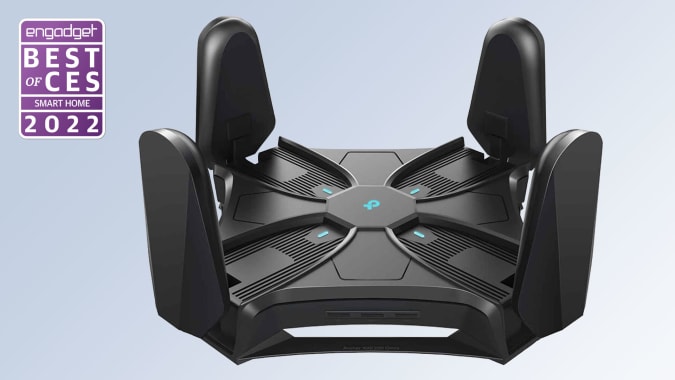
TP-Link
It wouldn’t be CES if we didn’t see some crazy routers, and TP-Link delivered this year. The TP-Link AXE200 Omni router has the over-the-top design that the company typically saves for its most expensive and powerful devices, but this model has a trick we’ve never seen before. It packs four mechanical antennas that can rotate automatically based on the placement and location of devices using your WiFi connection.
Sure, this feature looks cool in action (almost anthropomorphic, even), but TP-Link’s history-making top-flight routers means this likely isn’t a gimmick. And the rest of its specs are top of the line, too. It has tri-band WiFi 6E, capable of delivering speeds of up to 11 Gbps. There are also 10 Gigabit ethernet ports for wired connections. Given how many devices most households have these days, having a powerful, reliable router is crucial to keeping everything online. TP-Link’s latest should be able to do that no matter how many gadgets you need to connect. — Nathan Ingraham, Deputy Editor / News
Best Phone or Tablet
Asus ZenBook 17 Fold
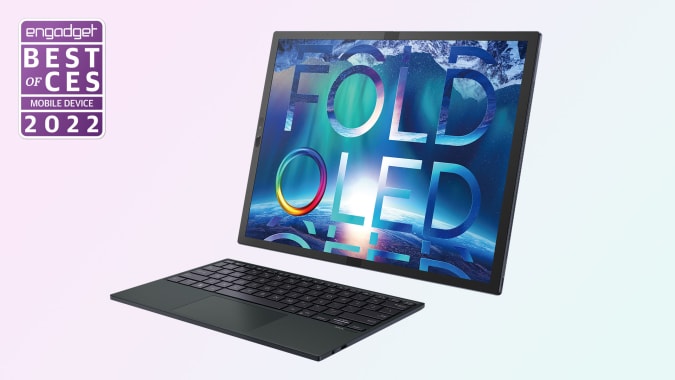
Asus
There was no shortage of mobile devices at CES this year, ranging from OnePlus’ new flagship to Samsung’s latest value-for-money phone. If the award should go to the most memorable, though, there was one clear pick. We’ve chosen ASUS’ ZenBook 17 Fold for attempting to redefine tablets, foldables and laptops in one fell swoop.
The foldable tablet category isn’t exactly novel, given past entries like Lenovo’s ThinkPad X1 Fold. ASUS’ offering is decidedly bolder, though, with a 17.3-inch OLED screen that offers a huge canvas and various usage possibilities (think: a book-like reader or a desktop PC). You’ll even have a usable laptop thanks to an included Bluetooth keyboard that allows the folded tablet to function as a 12.5-inch Windows laptop. All told, this is one of the most versatile tablets we’ve seen, and it could replace more than just your notebook depending on how you use it. — Jon Fingas, Weekend Editor
Best TV Tech
Samsung QD-Display
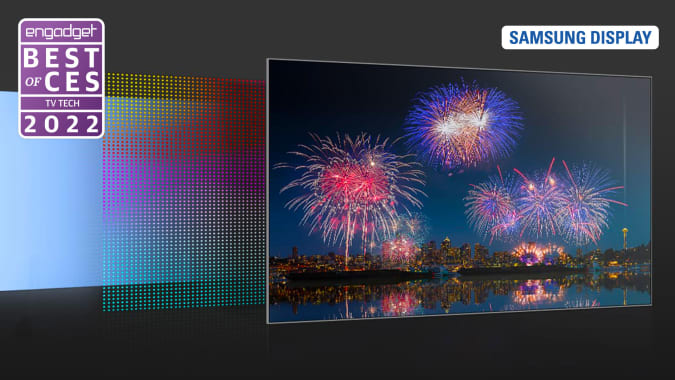
Samsung Display
We’ve praised LG’s OLED TVs for years, mainly because they represent a huge upgrade over LCDs in almost every way. Their one big weakness is brightness: LCDs rely on backlights that can reach far beyond a single OLED, which can’t burn too hot or they risk failure. OLEDs also lose a bit of color accuracy the brighter they get. Now Samsung believes it has a solution: QD-Display, an updated OLED technology that relies on quantum dots to supercharge colors and deliver more brightness. On paper, it seems like the biggest advancement in TV technology we’ve seen in years.
While Samsung isn’t showing off its own QD-Display TVs yet, Sony leapt at the chance to adopt the technology for its new A95K premium TV. That proves it’s more than just an expensive tech demo for the super rich, like Samsung’s MicroLED-equipped “The Wall.” It’s certainly ironic that Samsung is heralding OLED now, after downplaying the technology in TVs for years and pushing QLED sets instead. But no matter: It’s better for consumers, and the industry overall, if there’s more than one company producing OLED TVs. — Devindra Hardawar, Senior Editor
Best Gaming Product
Sony PlayStation VR2
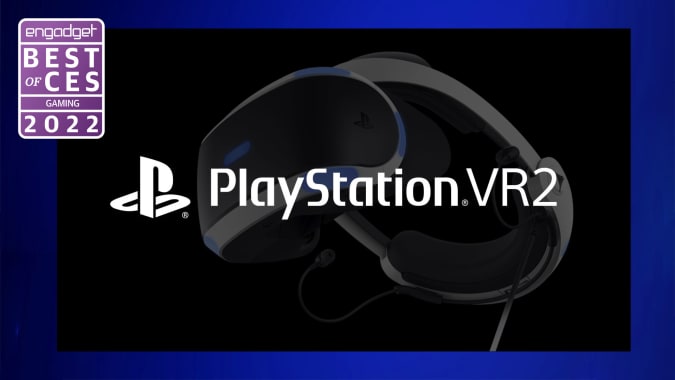
Sony
Among the souped-up graphics cards, laptop chips, desktop concepts and console accessories on display at CES 2022, the most exciting gaming announcement involved no actual product at all. Sony revealed the name, logo and specs for its next virtual reality headset, PlayStation VR2, and even though the device didn’t make an appearance, the details were enough to get us excited about the upcoming headset.
The PS VR2 has a display resolution of 2,000 x 2,040 for each eye, a 110-degree field of view, 4K HDR capabilities and frame rates of 90Hz or 120Hz. The new device has upgraded eye-tracking software and it also supports foveated rendering, a gaze-based feature common in high-end PC headsets. The addition of inside-out tracking means it doesn’t require an external camera – a nice step up from the original PS VR. The most surprising detail about the PS VR2 is the fact that it includes an internal motor that can make the headset vibrate, providing a new level of haptic feedback (or maybe just a headache).
In addition to all those details, Sony confirmed an original game in the Horizon universe is heading exclusively to the headset, and developer Guerrilla gave us a quick tease of first-person robot-dino hunting. Console gaming news at CES is a rarity, which makes Sony’s showing this year stand out, even without any actual hardware. — Jessica Conditt, Senior Editor
Best Laptop
Lenovo ThinkPad Z Series
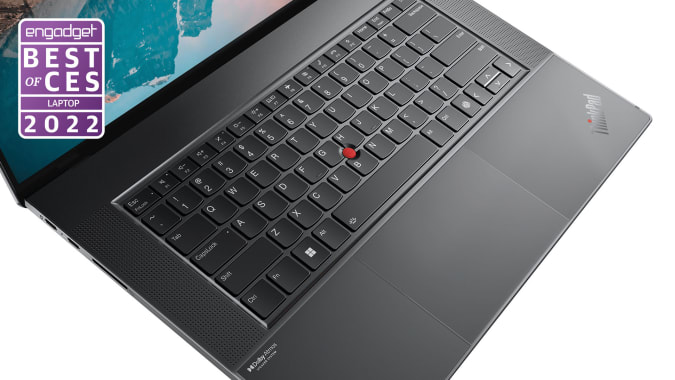
Lenovo
Come for the lid; stay for the sustainability. Or maybe it’s the other way around. When we first saw the ThinkPad Z series at a private demo ahead of CES, we were immediately charmed by its lid, which is designed to be openable with just one hand. But as we learned more about these sleek laptops, available with 13- and 16-inch screens, we were impressed with their focus on sustainability, including materials like recycled aluminum and vegan leather, and a charger made of 90 percent recyclable material. Even the packaging is 100 percent recyclable, thanks to compostable materials like bamboo and sugarcane.
We haven’t even talked about the potentially solid performance. The Z13 and Z16 are the result of a collaboration with AMD. In fact, these are among the first machines with AMD’s high-performance Ryzen PRO 6000 Series laptop processors. On the outside, the Z13 boasts a 2.8K OLED display while the 16 has a 4K screen, also OLED. Both machines support Dolby Vision, along with Dolby Atmos and Dolby AI noise cancellation. We look forward to reviewing them closer to when they go on sale in May. — Dana Wollman, Editor-in-chief
Best Sustainable Product
Goodyear 70% Sustainable-Material Tire
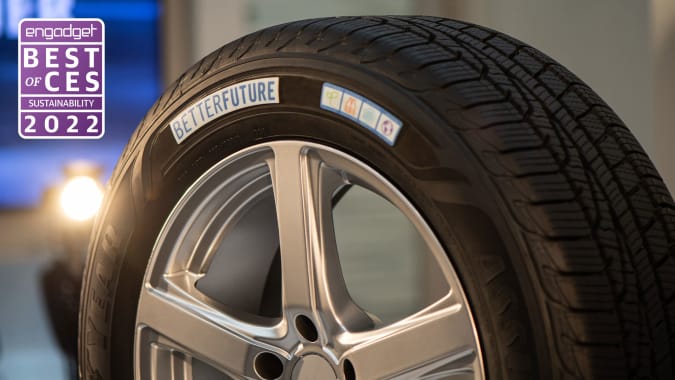
Goodyear
Whether it’s powered by an internal combustion engine or an electric battery, a vehicle’s tires remain one of its least eco-friendly components. Traditional tires are resource intensive to produce and difficult to dispose of, with only a small fraction of them ending up actually being recycled. As such, Goodyear two years ago set an ambitious goal for itself: develop a 100-percent sustainable tire by 2030. Two years into this project, the company is already well on its way toward meeting that goal.
Earlier this week, the company unveiled its 70-percent sustainable concept tire, which features 13 ingredients across nine different tire components that were formerly made with petroleum and other non-renewable resources. For example, carbon black and other petrol-based rubbers are typically used as filler materials to enhance a tire’s durability and usable lifespan. Goodyear has substituted these with more eco-friendly methane, carbon dioxide and plant-based oil, all of which are produced in ways that generate fewer greenhouse gasses than carbon black. Additionally, Goodyear employs silica, which increases a tire’s grip on the road, that has been derived from rice husk ash, a common by-product of the rice milling process.
Whether Goodyear releases a tire utilizing all of its sustainable technologies by 2030, or simply works individual materials into upcoming models, the environment still stands to benefit. — Andrew Tarantola, Senior Editor
Best Wildcard
BMW iX Flow featuring E Ink

BMW
When it comes to CES, there are so many left-field products on display that it can sometimes be hard to define a “wildcard.” Is it a futuristic concept, a bizarre novelty, or simply something you had no idea would be good until it was presented to you? This year, BMW’s iX Flow featuring E Ink ticked the “well, we didn’t expect that” box the hardest, and it’s certainly a striking concept. Essentially, BMW coated the skin of its iX car with the same electrophoretic coating you’ll find in most e-readers. The pitch being that, at the touch of a button, you can change the color of your vehicle to reflect your current mood. You know, as one does.
Of course, while the BMW iX itself is a road-ready car, the E Ink coating isn’t something you can expect to buy in the near future. But even being able to switch from black to white makes plenty of sense in these more energy-conscious times. In warm weather, you can paint the car white and help reflect some of the sun’s heat, reducing the drain on your AC. And when it gets cold, you can reverse the process, helping to store up more warmth to keep you, and your battery, nice and cozy. Even better, if the company gets a color E Ink version working, then we never need to worry about being stuck with someone else’s idea of a good paint job. — Daniel Cooper, Senior Editor
Best of the Best
Chevrolet Silverado EV
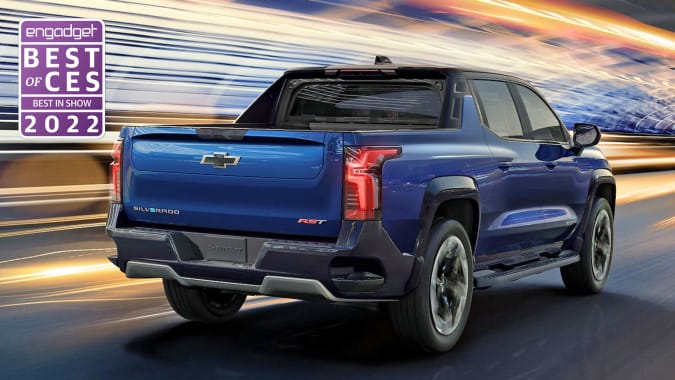
Chevrolet
CES 2022 brought us a bevy of innovative announcements from the automotive industry, from chameleon-skinned BMWs to a sun-soaked 600-mile electric Mercedes. But as ranked-choice systems are wont to do, there can be only one overall winner. This year, the king of the CES hill is Chevrolet’s Silverado EV, an electrified pickup that is sure to give both global warming and rival EV, the Ford F-150 Lightning, a run for their money.
The Silverado is already one of America’s most popular pickup models, having sold more than half a million US units in 2021 alone. Pickups and SUVs in general are far and away the best selling vehicle types in the US but those same buyers have historically been reticent to adopt more eco-friendly alternatives to conventional internal combustion cars and trucks — heck, just a few years ago many diesel owners were giddily “rolling coal” for the social media clout. But as fuel prices and sea surface temperatures continue to rise, the prospect of driving up to 400 miles (or more!) using nothing but a battery has become a compelling feature for drivers and automakers alike.
GM has already pledged to sell “30 new global electric vehicles by 2025” starting with the Hummer EV, which is already being delivered to early buyers. The Chevy Silverado, Blazer, Equinox and GMC Sierra all poised for production runs of their own starting in 2023. And once these EVs roll off their respective assembly lines, they’ll be faced with stiff competition from Ford, Tesla, Rivian, Toyota and other car makers eager to cash in on America’s newfound love affair with electrified pickups. — Andrew Tarantola, Senior Editor
All products recommended by Engadget are selected by our editorial team, independent of our parent company. Some of our stories include affiliate links. If you buy something through one of these links, we may earn an affiliate commission.
